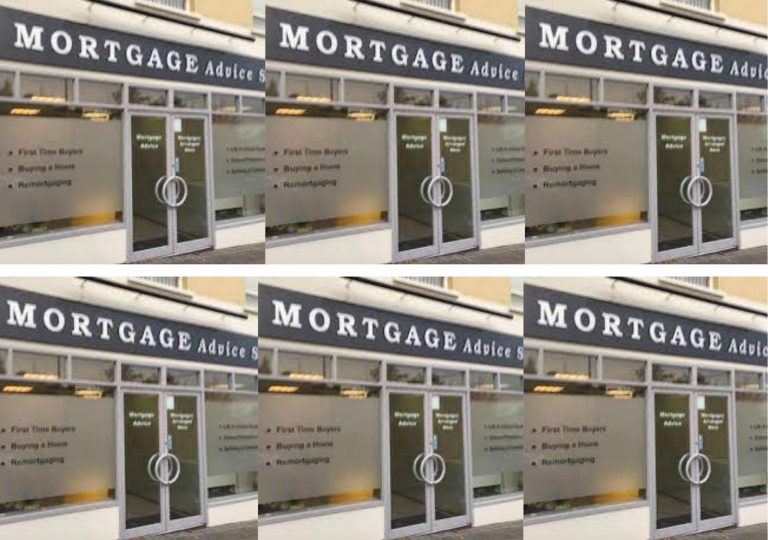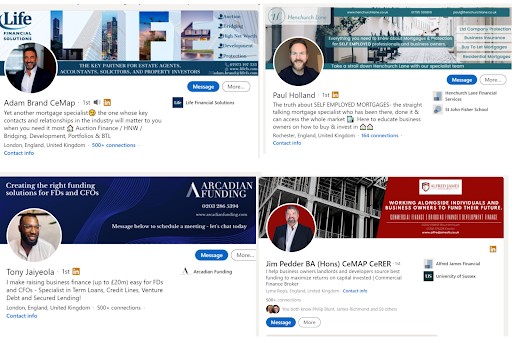What Type of Client Do You Want to Attract?
There are 48,000 advisers registered in the UK.
The message on the market is clouded, diluted, and it all sounds the same.
If you imagine the days of having a shop on the high street, this is what you would look like without a niche:

How attractive does that look?
How does the customer know which mortgage advisor to work with?
Now for the digital version →
We’re not on the high street as much, so this is what it looks like online when you’re advertising your mortgage business through your LinkedIn profile or Facebook page.

I know what you’re thinking…
“If I niche down then I am putting off everyone else outside of my niche who might want a mortgage too”
Was I right? Is that what you’re thinking?

I would say, 98% of mortgage advisers I speak to, do not niche down because they approach this exercise with a scarcity mindset. They think that by having a niche they’re blocking themselves from attracting customers outside of that niche.
Why Having a Niche Is Important
Having a niche doesn’t put the RIGHT people off. The benefits of having a niche are:
- You become the obvious choice for that specific target market
- You reduce the competition because you’re a specialist
- You will be more memorable
- You can focus on the deals that really pay off
- A specialist always earns more!
Firstly, if you feel that having a niche is a blocker, then that tells me 1 thing: You’re not IN LOVE with your niche.
What does that mean?
It means that, if you would have done your research correctly on your niche (and I will show you how later) then before picking it as a niche you should know if there is enough of a market for it to make it worth your while.
I don’t want to teach anyone to suck eggs here but… Business 101: Is there enough of a market for what you offer? What is the problem? Can you solve it?
That’s it.
If your niche is lucrative enough, then rather than seeing it as a limiting factor to your business, see it as having found a pot of gold!

How do I know which niche to pick? Here is how:
Take 1 day or 1 afternoon out from working IN the business and spend it working ON the business doing the following:
STEP 1
From your recent completions in the past 18 months, pick 3 customers that match the following 3 categories:
1): Which client was your highest earner? 💸 How much did you earn? Why? What did the customer need? What solutions did you offer? List the products and solutions that you offered this client.
2): Pick a type of client type that keeps repeating itself i.e. First time landlord, First time buyer, Self employed with less than 2 years accounts, 50+, 20 to 30 year old first time buyers etc.
This one is going to take a little longer. You need to look at the patterns within your business from the last 18 months worth of completions. What kind of case/customer do you get more of.
Example: A client recently discovered this pattern: out of all the clients, he noticed he had more CIS workers in comparison to PAYE. This realisation, led him to understand which niche he should start looking at. Another advisor realised that it wasn’t the type of client that kept repeating in the business but a specific PRODUCT which led him to niche down on that specific type of product because it is what he did a lot of.
3): Which client did you absolutely LOVE working with. Pick a client you have recently dealt with who was a dream to work with and you would love 100 more like them.❤️
STEP 2
What is the case split in your business? I.e 50% residential, 40% BTL, 10% commercial. Go into more detail: do you have other subcategories in your business → adverse, high networth, inexperienced landlords, professional landlords etc.
STEP 3
Where do the majority of your leads come from. If you say ‘referrals’ be more specific and state exactly WHO is referring these leads. I.e do most of your referrals come from accountants, estate agents? Developers?
STEP 4:
Now that you have the names of your top 3 clients, the next step is to print out 3 versions of this customer avatar worksheet below.
Answer the following questions for each client that you picked above: What’s the name of the client, How did they find you/how did you find them, What problem did they come to you with etc.
Remember to be specific. Each worksheet should be about your actual client.
Once you have completed the worksheet (x3) zoom out and take a birds eye view of your findings. What patterns can you see emerging?
What do I do with my niche now?
If you have made it this far and you have completed the exercises above, then you should have a pretty good idea of what type of niche you have. Do you have it?
Different types of niches I have worked on with clients to give you more hints:
- Self employed with less than 2 years trading experience
- Ltd company directors
- IT professionals
- Medical professionals
- Single mums
- CIS income
- Teachers
- Chinese investors/landlords
- Property developers
- Accountants
- Estate agent referral leads
- First time buyers in their 30s
- Adverse credit
- Furniture Finance
- Construction company owners
- Divorcees
- Finance Directors and CFOs
- Musicians
- Polish speaking clients
- Spanish speaking clients
- First time landlords
- HMO landlords
- Investors interested in buying land
- Indian community
- Ex high street bankers
- MDs and CEOs of pharmaceutical companies
The possibilities are endless…
Now that you have your niche, what can you do with it?
The worksheet should have helped you to discover WHO your ideal client is, WHAT they look like, WHERE they are and where there are more of them, what they want help with, what their PAINS and CHALLENGES are, and …. What SOLUTIONS help them.
Knowing these details means you can now start to:
- Communicate more effectively to that target audience
- Identify them more easily
- Tailor your message to suit that particular audience
- Adjust your profile to speak the language of your ideal customer (see example profiles below)
- Create content that addresses the pains and challenges of your target audience
Broker profile examples with a niche I helped them pick:

Creating Content to Suit Your Niche
NOW this is where the magic happens…
If you know who your ideal customer is then you know what they want!
Writing random content on your social media pages or your website, regardless of how well it is written, won’t mean anything if read by the wrong person!
Take for example a first time buyer – Tom…
…Tom has never had a mortgage. …
…Just about got a deposit together with his girlfriend Tara…
…Never lived on his own away from home…
…Excited to buy his first home but nervous at the same time…
What questions, problems and queries is Tom likely to have? What might he need help with?
5 content ideas suitable for Tom
- How to apply for a mortgage
- What documents are needed for the mortgage application
- How long does a mortgage take from application.
- What to expect when viewing a property and how to make an offer
- 95% mortgages – how does it work
Now think about Kim. Kim is a savvy business investor and professional landlord. She has 7 properties and also runs a property management business for other clients.
What would Kim think of the 5 pieces of content above? Are they relevant? Do they add value?
THIS IS WHY YOU NEED A NICHE AND STICK TO IT. WRITE CONTENT THAT IS RELEVANT FOR THAT NICHE.
If your customers were landlords and property investors as savvy as Kim, they would be put off by your content pieces above that are really more suited to clients like Tom.
Likewise, if you wrote lots of great content about expanding your property portfolio, buying commercial properties and diversifying your portfolio, you would confuse the hell out of Tom.
Content is not: How well is it written? How pretty does the image look?
Content IS: Answering your client’s most burning questions and solving their problems.

Top Tips for Content
- Don’t sell. EDUCATE.
- Have a mixture of long form and short form content
- Include images, gifs, emojis
- Use links in your content to expand the reader’s knowledge
- Use links to further guide the reader or drive traffic to a certain page
- Research hashtags that are relevant
- Be consistent. You want to be posting a couple of times per week on social media and at least once a month on your website
- Articles and Blogs work best on your website but you can also post them on LinkedIn
- Shorter text is better for Facebook and Instagram
- Invest in a bit of seo and adwords on Google
We know your time is soooo precious and that it’s better spent in front of clients giving advice, BUT content is super important because this is what people see BEFORE they start working with you so make sure you either
1.Invest your own TIME in getting the content done right
or
2. Invest your money in getting someone else to do it right.
If you so wish to choose option 2, you know where we are 😉
07748445230


